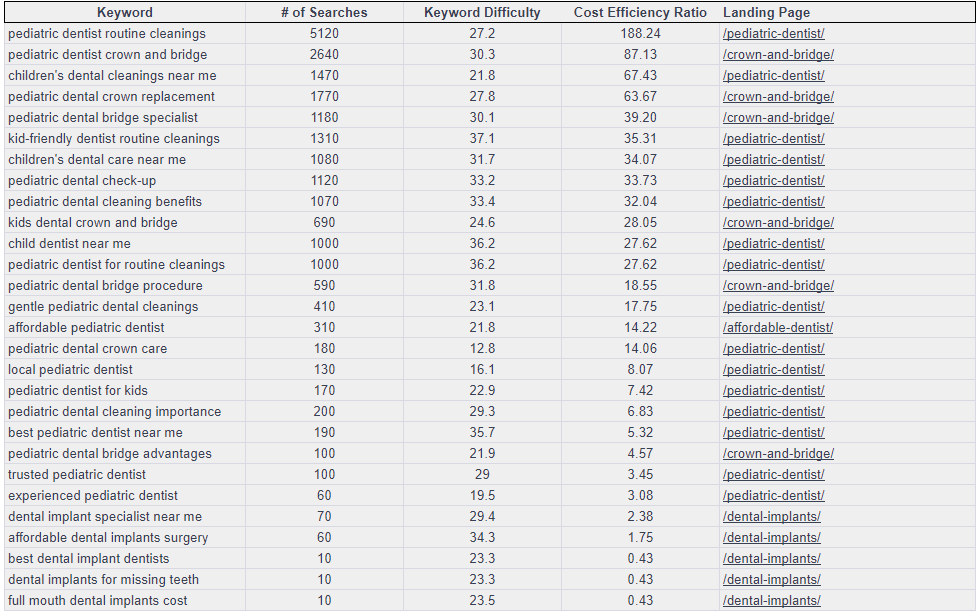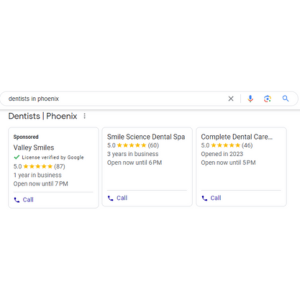This guide will cover the bare essentials for how to grow a dental practice in 2023. We will cover:
- Step 1: Specify your ideal patient
- Step 2: Optimize Google My Business
- Step 3: Set-up Patient Referral Programs
- Step 4: Optimize Your Website for Organic Search
- Step 5: Paid Advertising and Google Ads
- Step 6: Tracking and Analyzing Marketing Efforts
Let’s outgrow your competitors!
Step 1: Who is the Ideal Patient?
This is absolutely crucial. Imagine trying to sell high-cost veneers in a low-income neighborhood. On the opposite end, if you had clientele looking for that Hollywood aesthetic smile, you probably wouldn’t be market your monolithic zirconia work. Knowing your ideal patient is like finding the perfect pair of dental gloves—they fit just right!
Here’s how you figure out your ideal patient:
Demographics: Examine your current customer base. What are the % breakdowns of age, gender, location, occupation, and income level?
Needs: What are the dental needs of your patients? Are you catering to families seeking routine checkups and cleanings, or are you specialized in cosmetic dentistry for adults looking to enhance their smiles? This knowledge will help you tailor your marketing later in this guide.
Communication Preferences: Are they tech-savvy and prefer online appointment bookings, or do they prefer a traditional phone call? This will indicate where we should find your customers. We need to meet them there with our marketing and communication. This will increase patient growth and patient retention.
Insurance and Payment Options: Are they covered by specific insurance plans, or do they prefer flexible payment options? Getting the interest of a customer is possible without this step, but actually getting that business requires offering suitable financial solutions that can enhance patient satisfaction and retention. Don’t let your marketing go to waste by skipping this step.
Referrals: Pay attention to the types of patients who refer others to your practice. They often share similarities with your ideal patient profile. Understanding why they are enthusiastic about your services can guide your marketing efforts.
Step 2: Optimize Google My Business
If you’ve ever searched for a restaurant on Google, you’ll always see this “local map pack” of 3 businesses within your vicinity.
Dentistry is exactly the same way. You need to tell Google exactly what you do so people can find you! Here are the most critical pieces of information:
1. Business Category – Important because Google serves up relevant businesses based on this data (i.e. when someone searches for “Dentistry services near me”). Google, will show a checkmark + “Provides dental services”.
2. Products & Services – Important because Google serves up relevant business based on this data also.
3. Business Details (Phone, Address)
4. Business description – Include 3 – 4 of the products / services in this business description so that Google further prioritizes you for similar searches.
5. Opening Date – Especially relevant if you’re an older business with more experience.

The more detail you have, the more Google decides you are a legitimate business. Local Search does this step first in our SEO process and we take a lot of care ensuring this information is accurate, comprehensive and up-to-date.
Step 3: Set-up Your Referral Program
This is the lowest hanging fruit because it’s free and highly effective. Make sure to check the following:
1. Easy referral process? – Is it ok if new patients just call your assistants? If not, make sure you have an online form to make the patient onboarding experience seamless.
2. Win-Win Situation in place? – If you don’t water your relationships, your practice will get very limited referrals. For most of our clients, this is by far the most effective form of marketing but it only works when there’s a reward / gratitude. At Local Search, we usually see this come in the form of discounts, gift-cards, and, for family-oriented practices, sincere handwritten cards thanking their patients for the referrals.
Step 4: Optimize Your Website for Local Search
Search Engine Optimization (or SEO) is absolutely possible without an agency. The process just takes some time to learn and maintain. There are three fundamentals to strong SEO:
1. On-page SEO (What is your website about?)
This is the process of formatting your web pages so that Google clearly understands your content. Your title, header titles, body paragraphs and meta descriptions must all cohesively respond to the search keyword that your audience expects. For example, if your page is about aligners, you would repeat that keyword and directly address that word in your content:
Title: Achieve Your Perfect Smile with Our Aligners | Expert Dentistry Services
Meta Description: Discover the power of aligners in achieving your dream smile. Our expert dentists offer advanced aligner solutions for a confident and comfortable teeth straightening journey.
H1 Header: Transform Your Smile with Our Aligners
H2 Header #1: The Benefits of Aligners for Straightening Teeth
H2 Header #2: Why Choose Our Expert Dentistry Services for Aligners
The tricky part is understanding which search terms to target in your area, and with which pages. Some searches are more popular but are more competitive than others, even if they’re loosely related. Local Search spends a significant amount of time prioritizing which keywords are the best bang for your buck, and then we build your pages to target “groups” of these keywords. Here’s an example of the data we discuss with our clients after evaluating competitors, key products and services.

2. Off-page SEO (How popular is your website?)
This is essentially Google’s “like” system that Facebook uses. Instead of likes, Google checks how many websites link to your webpage. Some of these links are worth more than others. For example, if your website is linked to by Forbes, that is much more likely to improve your rankings versus someone who mentions you on their small private blog. This matters far less if you’re a local business with less competition.
Building this is like building a social media following. You can reach out to blogs asking if they’ll link back to you. You can also offer to write content for other blogs so that they’ll mention your company. Forum submissions, article submissions, influencer outreach and building your company’s web presence is the best way to organically grow popularity.
Obviously this is a very time-consuming process. Web agencies like Local Search take care of this outreach and content creation for you as part of SEO service package.
3. Technical SEO (How well does your website run?)
This is the least important factor in SEO but is still important. If your website is slow and unresponsive, Google will prefer not to serve you up when people are searching. Similarly, if Google has a difficult time crawling your website to understand what it’s about, it will also prefer not to recommend you when people are searching.
Google Pagespeed Insights is a great starting point but ultimately you’ll want someone with more extensive tools like SEO Powersuite’s Website Auditor to help you diagnose.
Contact us here and our team can provide a free audit of your website. We’ll suggest fixes that you can take to any agency!
Step 5: Google Pay-Per Click Advertising
Paid Advertising is a way to speed up the growth process. Targetted marketing has made advertising cheaper, faster and more responsive than ever before. There a couple ways you can do this:

Google Ads
Show up first as a sponsored result when folks search for “Aligners near me” (for example)”. This is the one of the most direct ways you can target potential customers because you can guess what they’re looking for.

Facebook Ads
Remember that ideal customer exercise we did? Dentists can leverage Facebook ads to reach potential patients based on their demographics, interests, and behaviors.

Instagram Ads
Great for patients aged between 18 and 34. Before-and-after photos, educational content, and patient testimonials, dentists can engage with their audience, build trust, and attract potential patients
(Image source: Ted Baker)
Step 6: Tracking and Analyzing Marketing Efforts
Why pay for ads if all of your new patients are all coming from referrals? Tracking data from your new patients is key to understanding where you can save your money and where you should spend more.
Here’s some data from one of our client’s marketing efforts:
For every $1 they spent on SEO, they got 7.5x that in revenue. That’s great!!
The client told us they wanted to hit the gas even more. They had a larger $5,000 / month budget in marketing spend. So to accelerate growth, we recommended they also do Google paid ads which is slightly less cost-effective at $3.10 for every $1 they pay.
Today, the client is much closer to retirement and we’re in discussions to pause their least profitable marketing channel. In this case it’s social media but this is not always true. Some niches in dentistry perform far better on social media than PPC Advertising on Google.

Whichever agency you choose to go with, make sure they give you a clear understanding of which channels are the most profitable for you. This is a good example why every client’s needs are different. From your industry to your growth expectations, to your investment time horizon, many factors go into deciding which channels are right for you. At Local Search, we work on providing this level of transparency from Day 1 with our clients.
Conclusion
That’s it! The ideas are simple. Depending on you area, your competitors and the services you provide, different strategies will be more effective than others. If you want an expert to do the work for you, schedule a free, no-obligation discussion with a consultant below!
Book your FREE competitive analysis today
Get a customized step-by-step improvement plan that you can take to any marketing agency.

